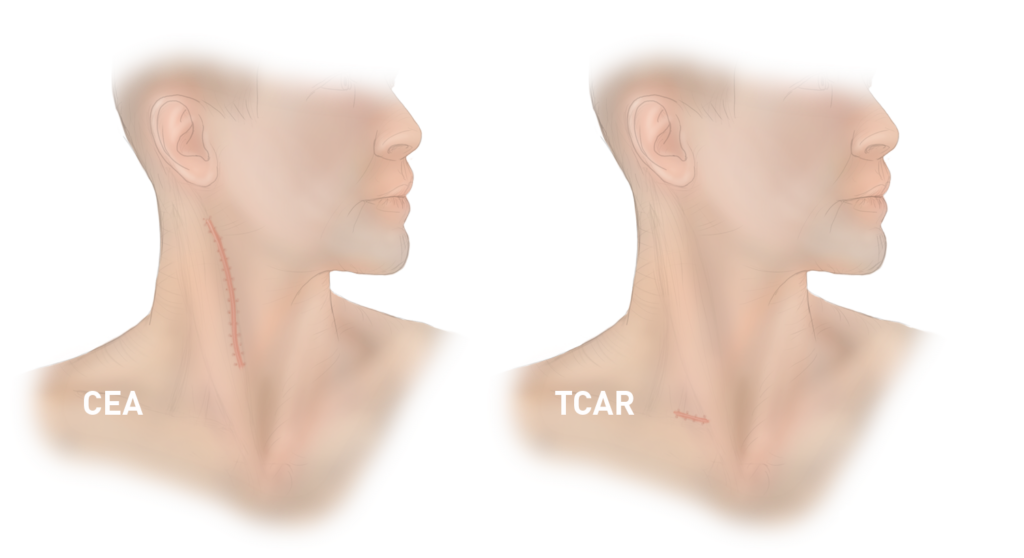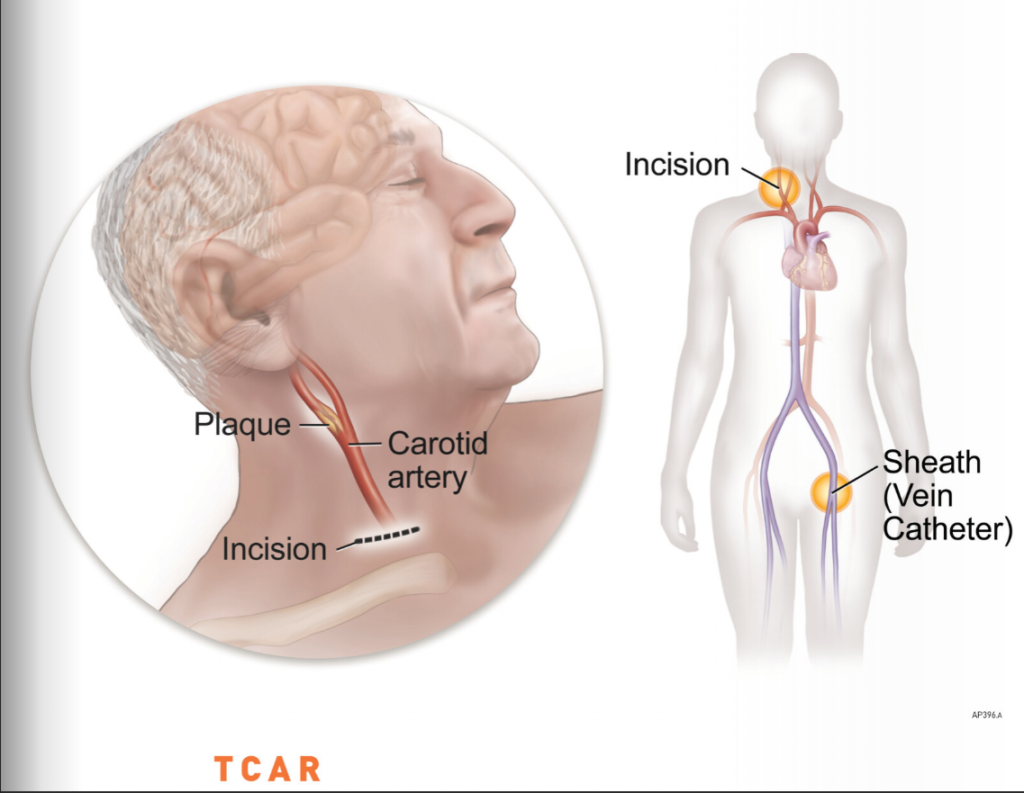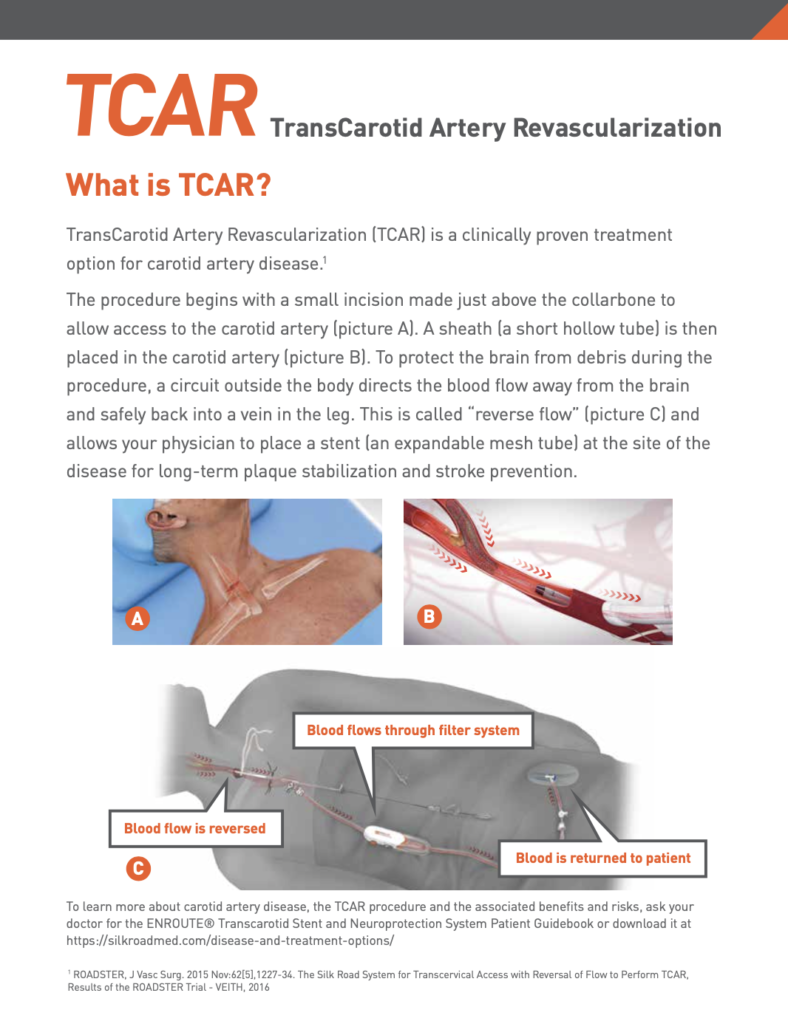Home » TCAR2
TransCarotid Artery Revascularization
We specialize in treating a wide array of venous disorders, utilizing our four non-invasive vascular.

What is TCAR?
TCAR is a patient-friendly, endovascular procedure that incorporates the neuroprotection principles of CEA. It utilizes the ENROUTE ® Transcarotid Neuroprotection System to temporarily reverse blood flow away from the brain, collecting any potential debris in the device filter, before returning the blood to a vessel in the leg. With reverse flow neuroprotection established, the ENROUTE ® Transcarotid Stent is then implanted in the lesion for long-term plaque stabilization and stroke prevention.

TCAR – Procedure Details
A small incision is made just above the collar bone to expose the common carotid artery. A soft, flexible sheath is placed directly into the carotid artery and connected to a system that will reverse the flow of blood away from the brain to protect against fragments of plaque that may come loose during the procedure. The blood is filtered and returned through a second sheath placed in the femoral vein in the patient’s thigh. The Neuroprotection system allows balloon angioplasty and stenting to be performed while blood flow is reversed. After the stent is placed successfully to stabilize the plaque in the carotid artery, flow reversal is turned off and blood flow to the brain resumes in its normal direction.

Carotid Disease
Carotid artery disease is a form of atherosclerosis, or a build-up of plaque in one or both of the main arteries of the neck. The carotid arteries are vital as they feed oxygen-rich blood to the brain. When plaque builds up in the carotid arteries, they begin to narrow and slow down blood flow, potentially causing a stroke if blood flow stops or plaque fragments travel to the brain.
Every year, 15 million people worldwide suffer a stroke, also known as a brain attack. Nearly 6 million die and another 5 million are left permanently disabled. Carotid artery disease is estimated to be the source of stroke in up to a third of cases, with 427,000 new diagnoses of the disease made every year in the United States alone
Carotid artery disease is typically silent and does not present with symptoms. Physicians can screen patients based on risk factors like high blood pressure, diabetes, obesity and smoking. Sometimes, patients are screened for carotid artery disease if the doctor knows the patient has vascular disease elsewhere in the body. Blockages can also be found when a physician hears a sound through a stethoscope placed on the neck. The sound is caused by blood flowing past the blockage.If someone is having stroke-like symptoms (weakness/numbness on one side, loss of eyesight/speech, garbled speech, dizziness or fainting), they should seek immediate medical attention and be evaluated for carotid artery disease. If you suspect a stroke, remember to act F.A.S.T.
The following tests may be performed if carotid artery disease is suspected:Carotid artery ultrasound: This test uses sound waves that produce an image of the carotid arteries on a TV screen and can be helpful in identifying narrowing in the carotid arteries. This test is painless and does not require the use of needles, dye or X-rays.Angiography: An angiogram uses X-rays to take a picture of the carotid artery. In order for the X-ray to “see” the arteries, a dye is injected through a small tube (catheter) inserted into an arteryin the groin or arm. This procedure will determine exactly where the narrowing is located and willhelp to guide further treatments.
Treatment options for carotid artery disease depend upon the severity of the overall patient condition and symptoms. Moderate disease may not require an interventional procedure, as some individuals can manage the disease with medications and lifestyle changes. More severe blockages may require surgery. Today, there are three primary surgical approaches:Carotid Endarterectomy (CEA): This open surgical procedure removes plaque from inside the carotid artery in order to restore normal blood flow to the brain. The surgeon makes an incision on the neck to access the affected artery, opens the artery and removes the plaque. The surgeon will then close the artery and the incision in the neck using stitches.Transfemoral Carotid Artery Stenting: In this minimally invasive alternative procedure, the physician works through a tube inserted into the artery in the upper thigh. First, a small umbrella-like filter is placed beyond the diseased area of the carotid artery to help limit fragments of plaque from traveling toward the brain during the procedure. The physician then inserts a slender, metal-mesh tube, called a stent, which expands inside the carotid artery to increase blood flow to the brain and stabilize the plaque.

Treatment options for carotid artery disease depend upon the severity of the overall patient condition and symptoms. Moderate disease may not require an interventional procedure, as some individuals can manage the disease with medications and lifestyle changes. More severe blockages may require surgery. Today, there are three primary surgical approaches:Carotid Endarterectomy (CEA): This open surgical procedure removes plaque from inside the carotid artery in order to restore normal blood flow to the brain. The surgeon makes an incision on the neck to access the affected artery, opens the artery and removes the plaque. The surgeon will then close the artery and the incision in the neck using stitches.Transfemoral Carotid Artery Stenting: In this minimally invasive alternative procedure, the physician works through a tube inserted into the artery in the upper thigh. First, a small umbrella-like filter is placed beyond the diseased area of the carotid artery to help limit fragments of plaque from traveling toward the brain during the procedure. The physician then inserts a slender, metal-mesh tube, called a stent, which expands inside the carotid artery to increase blood flow to the brain and stabilize the plaque
TransCarotid Artery Revascularization (TCAR) is a hybrid procedure that was developed to treat patients with carotid artery disease who are at risk for open surgery. • The entire TCAR procedure is performed through asmaller incision in the neck and in less than half thetime of a carotid endarterectomy – limiting thestress on the heart and significantly cutting the riskof the patient having a stroke or heart attack duringthe procedure.• During the TCAR procedure, a tube inserted intothe carotid artery is connected to a system thattemporarily directs blood flow away from the brainto protect against dangerous debris from reachingthe brain and causing a stroke during the procedure.Surgeons filter the blood before returning it to avein in the groin, and a stent is implanted to thecarotid artery to stabilize plaque and help preventfuture strokes.• Patients who undergo the TCAR procedure recoverquickly and almost always go home the next day toreturn to full and productive lives with less pain andsmaller scars than traditional treatments, and areduced risk of future strokes

IMPORTANT TCAR INFORMATION
It is important to follow your physician’s instructions for medications before and after this procedure. Drink plenty of water before midnight the day before your procedure. Should you be told otherwise please consult with your physician right away.
WHAT TO EXPECT AFTER YOUR PROCEDURE
- Most patients are able to go home the day following the procedure
- You may experience some pain after this procedure, but it should be minimal

- Follow all your physician’s instructions for taking care of your incision site
- If you experience unusual headaches, dizziness or other unusual symptoms, call the physician whoperformed your procedure immediately or dial 911
DIGITAL RESOURCES
Designed as a picture aid for describing TCAR and CEA
IMAGES
Images of carotid disease, TCAR & CEA scar, and the NPS


